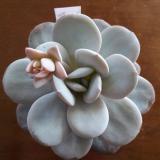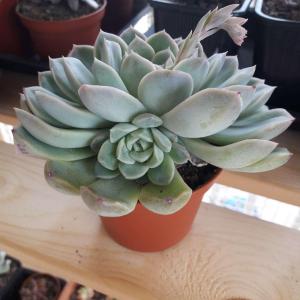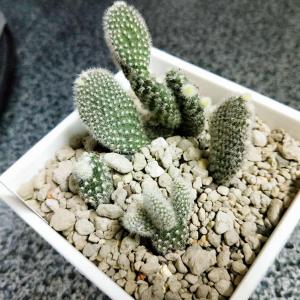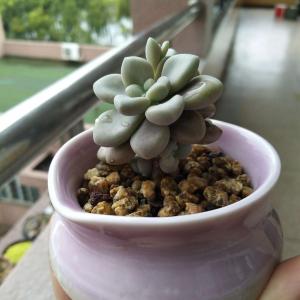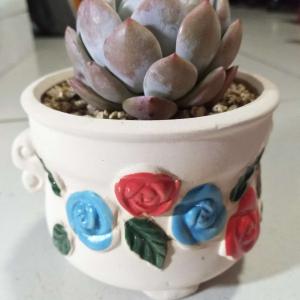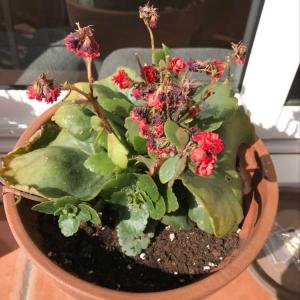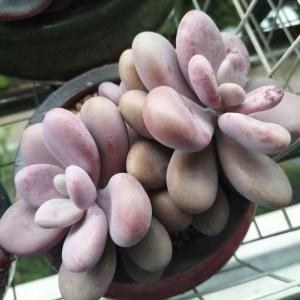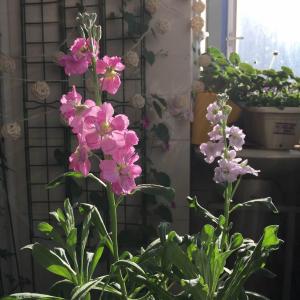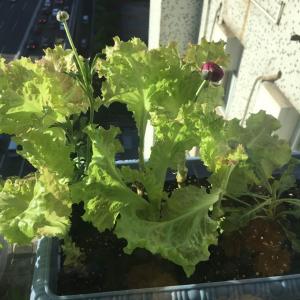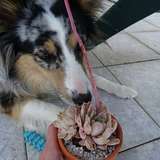文章
Miss Chen
2018年03月19日

Description: This wildflower is an annual or biennial about ½–2' tall. Small plants are unbranched or sparingly branched, while large plants form frequent lateral stems in the upper leaf axils. The stems are light green to reddish purple, 4-angular, and slightly winged; the central stem is erect, while the lateral stems curve upward. Pairs of opposite leaves occur along each stem, each pair rotating about 90° from the pair of leaves immediately below. The leaves are up to 2½" long and about half as much across, becoming slightly smaller as they ascend the stems. The leaves are ovate-cordate to ovate, sessile or slightly clasping at their bases, and smooth along their margins. Their upper surfaces are yellowish green, green, or tinted slightly purple; each leaf has 3-5 parallel veins. Both the stems and leaves are hairless.
The central stem and upper lateral stems (if present) terminate in clusters of 3-7 flowers on short pedicels. Frequently, there are additional clusters of 1-5 flowers from the axils of the upper leaves. All of these flowers are held stiffly erect. Each flower is about ¾" long and ¼" across; it has a long tubular corolla and a short green calyx with 5 slender teeth. The apex of each corolla has 5 triangular lobes that fold together to form a point; the corolla is closed or nearly so. There are no interconnecting fringes to join these lobes. The corollas are blue-violet, purple, or nearly white; they have fine purple veins along their sides. Inside each corolla, there are five stamens and a pistil. The erect lobes of the calyx are narrowly oblong-lanceolate in shape. Underneath the clustered flowers, the leaves are reduced to leafy bracts. The blooming period occur from late summer to mid-fall and lasts about 1-2 months. There is no noticeable floral scent. Each flower is replaced by a seed capsule that dividesDistribution Map into 2 parts to release the numerous tiny seeds. These seeds are distributed by wind and water. The root system consists of a taproot. This wildflower reproduces by reseeding itself; it does not spread vegetatively.
Cultivation: The preference is full sun to light shade, moist to dry conditions, and a somewhat barren soil containing clay or rocky material. Competition from taller plants should be restricted. The size of individual plants and the abundance of their flowers can vary considerably depending on the availability of moisture and nutrients.
Range & Habitat: The native Stiff Gentian is occasional in the northern half of Illinois, while in the southern half of the state it is rare or absent. Populations of this species may be declining. Habitats include hill prairies, upland savannas, thinly wooded slopes, rocky meadows, banks of streams in wooded areas, calcareous seeps, and edges of cliffs. This species is usually found in high quality natural habitats, often where limestone is close to the ground surface.
Faunal Associations: So far, information about floral-faunal relationships for this species has not been encountered. The long tubular shape of the closed corollas suggests that long-tongued bees cross-pollinate the flowers.
Photographic Location: The edge of a partially shaded cliff at the Pine Hills Nature Preserve in west-central Indiana.
Comments: Like several other gentian species, the flowers of Stiff Gentian provide attractive blue-violet color during the fall; this is one of the last species to remain in bloom. Stiff Gentian in Illinois consists of var. occidentalis; the typical variety is found east of Ohio. Stiff Gentian is easily distinguished by its peculiar flowers, which are shorter (1" long or less) and more narrow (¼" across) than the flowers of other gentians with closed corollas. Sometimes, Stiff Gentian is still referred to as Gentiana quinquefolia, but this genus has been reserved for the perennial gentians, of which there are several species still extant in Illinois.
The central stem and upper lateral stems (if present) terminate in clusters of 3-7 flowers on short pedicels. Frequently, there are additional clusters of 1-5 flowers from the axils of the upper leaves. All of these flowers are held stiffly erect. Each flower is about ¾" long and ¼" across; it has a long tubular corolla and a short green calyx with 5 slender teeth. The apex of each corolla has 5 triangular lobes that fold together to form a point; the corolla is closed or nearly so. There are no interconnecting fringes to join these lobes. The corollas are blue-violet, purple, or nearly white; they have fine purple veins along their sides. Inside each corolla, there are five stamens and a pistil. The erect lobes of the calyx are narrowly oblong-lanceolate in shape. Underneath the clustered flowers, the leaves are reduced to leafy bracts. The blooming period occur from late summer to mid-fall and lasts about 1-2 months. There is no noticeable floral scent. Each flower is replaced by a seed capsule that dividesDistribution Map into 2 parts to release the numerous tiny seeds. These seeds are distributed by wind and water. The root system consists of a taproot. This wildflower reproduces by reseeding itself; it does not spread vegetatively.
Cultivation: The preference is full sun to light shade, moist to dry conditions, and a somewhat barren soil containing clay or rocky material. Competition from taller plants should be restricted. The size of individual plants and the abundance of their flowers can vary considerably depending on the availability of moisture and nutrients.
Range & Habitat: The native Stiff Gentian is occasional in the northern half of Illinois, while in the southern half of the state it is rare or absent. Populations of this species may be declining. Habitats include hill prairies, upland savannas, thinly wooded slopes, rocky meadows, banks of streams in wooded areas, calcareous seeps, and edges of cliffs. This species is usually found in high quality natural habitats, often where limestone is close to the ground surface.
Faunal Associations: So far, information about floral-faunal relationships for this species has not been encountered. The long tubular shape of the closed corollas suggests that long-tongued bees cross-pollinate the flowers.
Photographic Location: The edge of a partially shaded cliff at the Pine Hills Nature Preserve in west-central Indiana.
Comments: Like several other gentian species, the flowers of Stiff Gentian provide attractive blue-violet color during the fall; this is one of the last species to remain in bloom. Stiff Gentian in Illinois consists of var. occidentalis; the typical variety is found east of Ohio. Stiff Gentian is easily distinguished by its peculiar flowers, which are shorter (1" long or less) and more narrow (¼" across) than the flowers of other gentians with closed corollas. Sometimes, Stiff Gentian is still referred to as Gentiana quinquefolia, but this genus has been reserved for the perennial gentians, of which there are several species still extant in Illinois.
0
0
文章
Miss Chen
2018年03月18日

Description: This perennial plant is 3-7' tall and usually unbranched. The central stem is light green and glabrous, except where the whorls of leaves of occur, where it is slightly swollen and purple. There are 3-4 leaves in each whorl along the stem. The leaves are about 6" long and 3½" across, or sometimes larger; they are broadly lanceolate or ovate and crenate-serrated along the margins. Each leaf is dull green and hairless on the upper surface; the lower surface is pale green and hairless to finely pubescent. The foliage may be vanilla-scented, although this varies with the local ecotype.
The central stem terminates in one or more panicles of compound flowers that are bunched together; this inflorescence is usually more dome-shaped than flat-topped. Unlike the central stem, the stalks of the inflorescence are sometimes finely pubescent. Each compound flower consists of 5-8 disk florets and several overlapping series of bracts at its base. There are no ray florets. The corolla of each disk floret is whitish pink to purplish pink; it is tubular in shape and has 5 tiny teeth along its upper rim. A divided white style is strongly exerted from each disk floret. The floral bracts are pale pink and oblong. The blooming period occurs from mid-summer to early fall and lasts about a month. Each floret is replaced by a bullet-shaped achene with a small tuft of hair. These achenes are dispersed by the wind. The root system is shallow and fibrous.

Cultivation: The preference is light shade to partial sun, moist to mesic conditions, and a rich loamy soil. The leaves will turn an unattractive yellowish green in the presence of strong sunlight.
Range & Habitat: The native Sweet Joe-Pye Weed occurs occasionally in most areas of Illinois, except for a few counties in SE Illinois and elsewhere in the state, where it is uncommon or absent (see Distribution Map). Habitats include open woodlands, savannas, woodland borders, thickets, partially shaded seeps, and partially shaded riverbanks. This plant can survive in wooded areas that are somewhat degraded. However, populations have a tendency to decline when the shade of overhead canopy trees becomes too dense.

Faunal Associations: The flower nectar attracts primarily long-tongued bees, butterflies, skippers, and moths. Bee visitors include Bombus spp. (bumblebees), Melissodes spp. (miner bees), and Megachile spp. (leaf-cutting bees). Some bees also collect pollen. The caterpillars of various moths feed on leaves and other parts of Eutrochium spp. (Joe-Pye Weed species), including Carmenta bassiformis (Eupatorium Borer Moth), Emmelina monodactyla (Common Plume Moth), Perigea xanthioides (Red Groundling), Schinia trifasciata (Three-Lined Flower Moth), Phragmatobia fuliginosa (Ruby Tiger Moth), and Eupithecia miserulata (Common Pug).

Other insect feeders include larvae of the leaf-mining flies Liriomyza pusilla and Phytobia allecta, larvae of Dasineura purpurea (Joe-Pye Blossum Midge), the warty leaf beetle Exema dispar, the aphid Uroleucon eupatoricolens, and the treehopper Entylia bactriana. White-Tailed Deer browse on the leaves of Sweet Joe-Pye Weed sparingly (personal observation), while the Swamp Sparrow eats the seeds of various Joe-Pye Weed species to a limited extent.
Photographic Location: A small opening in a wooded area at Meadowbrook Park in Urbana, Illinois.

Comments: Sweet Joe-Pye Weed (Eutrochium purpureum) is one of the taller wildflowers in wooded areas. It is often found in habitats that are more shady and dry than other Eutrochium spp. (Joe-Pye Weed species) in the state. To identify a Joe-Pye Weed, it is helpful to examine the central stem: the stem of Sweet Joe-Pye Weed is solid in cross-section and purple where the bases of leaf petioles occur, otherwise it is green and glabrous. The species Eutrochium maculatum (Spotted Joe-Pye Weed) has solid stems that are either purple-spotted and glabrous or solid purple throughout from dark-colored hairs, while Eutrochium fistulosum (Hollow-stemmed Joe-Pye Weed) has hollow stems that are glabrous and glaucous. Sweet Joe-Pye Weed usually has only 3-4 leaves per whorl, while Spotted Joe-Pye Weed has 4-5 leaves per whorl and Hollow-Stemmed Joe-Pye Weed has 4-7 leaves per whorl. Joe-Pye Weed species have been assigned recently to the Eutrochium genus; in the past, they have been assigned to the Eupatorium genus and the Eupatoriadelphus genus. Thus, Eupatorium purpureum and Eupatoriadelphus purpureus are scientific synonyms of Sweet Joe-Pye Weed.
The central stem terminates in one or more panicles of compound flowers that are bunched together; this inflorescence is usually more dome-shaped than flat-topped. Unlike the central stem, the stalks of the inflorescence are sometimes finely pubescent. Each compound flower consists of 5-8 disk florets and several overlapping series of bracts at its base. There are no ray florets. The corolla of each disk floret is whitish pink to purplish pink; it is tubular in shape and has 5 tiny teeth along its upper rim. A divided white style is strongly exerted from each disk floret. The floral bracts are pale pink and oblong. The blooming period occurs from mid-summer to early fall and lasts about a month. Each floret is replaced by a bullet-shaped achene with a small tuft of hair. These achenes are dispersed by the wind. The root system is shallow and fibrous.

Cultivation: The preference is light shade to partial sun, moist to mesic conditions, and a rich loamy soil. The leaves will turn an unattractive yellowish green in the presence of strong sunlight.
Range & Habitat: The native Sweet Joe-Pye Weed occurs occasionally in most areas of Illinois, except for a few counties in SE Illinois and elsewhere in the state, where it is uncommon or absent (see Distribution Map). Habitats include open woodlands, savannas, woodland borders, thickets, partially shaded seeps, and partially shaded riverbanks. This plant can survive in wooded areas that are somewhat degraded. However, populations have a tendency to decline when the shade of overhead canopy trees becomes too dense.

Faunal Associations: The flower nectar attracts primarily long-tongued bees, butterflies, skippers, and moths. Bee visitors include Bombus spp. (bumblebees), Melissodes spp. (miner bees), and Megachile spp. (leaf-cutting bees). Some bees also collect pollen. The caterpillars of various moths feed on leaves and other parts of Eutrochium spp. (Joe-Pye Weed species), including Carmenta bassiformis (Eupatorium Borer Moth), Emmelina monodactyla (Common Plume Moth), Perigea xanthioides (Red Groundling), Schinia trifasciata (Three-Lined Flower Moth), Phragmatobia fuliginosa (Ruby Tiger Moth), and Eupithecia miserulata (Common Pug).

Other insect feeders include larvae of the leaf-mining flies Liriomyza pusilla and Phytobia allecta, larvae of Dasineura purpurea (Joe-Pye Blossum Midge), the warty leaf beetle Exema dispar, the aphid Uroleucon eupatoricolens, and the treehopper Entylia bactriana. White-Tailed Deer browse on the leaves of Sweet Joe-Pye Weed sparingly (personal observation), while the Swamp Sparrow eats the seeds of various Joe-Pye Weed species to a limited extent.
Photographic Location: A small opening in a wooded area at Meadowbrook Park in Urbana, Illinois.

Comments: Sweet Joe-Pye Weed (Eutrochium purpureum) is one of the taller wildflowers in wooded areas. It is often found in habitats that are more shady and dry than other Eutrochium spp. (Joe-Pye Weed species) in the state. To identify a Joe-Pye Weed, it is helpful to examine the central stem: the stem of Sweet Joe-Pye Weed is solid in cross-section and purple where the bases of leaf petioles occur, otherwise it is green and glabrous. The species Eutrochium maculatum (Spotted Joe-Pye Weed) has solid stems that are either purple-spotted and glabrous or solid purple throughout from dark-colored hairs, while Eutrochium fistulosum (Hollow-stemmed Joe-Pye Weed) has hollow stems that are glabrous and glaucous. Sweet Joe-Pye Weed usually has only 3-4 leaves per whorl, while Spotted Joe-Pye Weed has 4-5 leaves per whorl and Hollow-Stemmed Joe-Pye Weed has 4-7 leaves per whorl. Joe-Pye Weed species have been assigned recently to the Eutrochium genus; in the past, they have been assigned to the Eupatorium genus and the Eupatoriadelphus genus. Thus, Eupatorium purpureum and Eupatoriadelphus purpureus are scientific synonyms of Sweet Joe-Pye Weed.
0
0
文章
Miss Chen
2018年03月16日

Grow your own salad at home with a backyard patch of lettuce (Lactuca sativa), which thrives throughout U.S. Department of Agriculture plant hardiness zones 4 through 9. Since this vegetable is prized for its crisp, edible leaves, yellowing foliage can ruin your dreams of a homemade salad harvest. Lettuce may turn yellow for a few common reasons, each which has an organic, natural solution.
Not Enough Water
The lettuce plant has a very shallow root system, which makes it especially prone to drought stress. The plant requires consistently moist soil conditions at all times, without which it will wilt, turn yellow and eventually lose all of its leaves.
When watering lettuce, use enough irrigation to moisten the soil to a depth of 6 inches. Water the lettuce bed again as soon as the top inch of soil has dried out.
Extreme Soil Temperature Fluctuations
Since lettuce roots lie so close to the soil surface, the plant is more prone to temperature-induced stress that can result in wilting and yellowing of the lettuce leaves. Mulch creates a protective barrier on the soil surface that helps to shield the soil from the sun and keeps temperatures constant and cool.

Spread 2 to 3 inches of organic mulch around the lettuce plants. Example mulching materials include:
Shredded leaves
Weed-free straw or hay
Fine bark chips
Compost
Additionally, mulch helps prevent weed growth and also conserves soil moisture, further enhancing the lettuce plant's health and appearance.
Poor Soil Nutrient Levels
As lettuce grows, it needs rich levels of soil nutrients to support optimal foliage development. Nutrient-depleted soil may result in lettuce plants that appear stunted with leaves that aren't fully developed or that have a pale, yellow-green hue. When given the right amount of fertilizer, lettuce leaves turn a dark green.
Before planting lettuce, set a nutritional foundation by spreading 1 1/2 pounds of 5-10-10 fertilizer for every 50 square feet of gardening space. A couple months after the lettuce has been planted, fertilize the garden again with 1/2 pound of 33-0-0 fertilizer for every 50 feet of lettuce row.
Pest Invasions
You are not the only thing that enjoys the taste of lettuce. Occasionally, lettuce beds may get attacked by a variety of soft-bodied pests, including aphids, leafhoppers and whiteflies. Left uncontrolled, pest infestations can reach such heavy numbers that they cause wilting, yellowing or loss of leaves. Some pests, such as the leafhopper, spread a disease called yellows disease that, true to its name, causes yellow leaves.
Dust lettuce plants with food-grade diatomaceous earth to protect it from leafhoppers and other leaf-eating pests. Repeat the diatomaceous earth application after any rainy days.

Alternatively, spray lettuce plants with a strong blast of water from a garden hose. This is often enough to dislodge and kill common pests like aphids and whiteflies, and regular spraying keeps pest populations at levels too low to cause a problem.
If all else fails, make your own homemade insecticide soap spray to kill aphids, leafhoppers and other soft-bodied pests.
Step 1
Place an entire garlic bulb and a small onion into a blender and blend on medium until a fine pulp is created.
Step 2
Add 1 teaspoon of powdered, dehydrated cayenne pepper.
Step 3
Add 1 quart of water.
Step 4
Mix thoroughly and allow to steep of an hour, but preferably overnight.
Step 5
Pour the liquid through a piece of cheesecloth into a plastic spray bottle.
Step 6
Add 1 tablespoon of liquid dish soap.
Step 7
Spray the soapy solution on affected lettuce plants. Coat all exposed surfaces of the plant, including the undersides of leaves where aphids and other pests tend to congregate.
Step 8
Repeat once a week until pest activity subsides.
Not Enough Water
The lettuce plant has a very shallow root system, which makes it especially prone to drought stress. The plant requires consistently moist soil conditions at all times, without which it will wilt, turn yellow and eventually lose all of its leaves.
When watering lettuce, use enough irrigation to moisten the soil to a depth of 6 inches. Water the lettuce bed again as soon as the top inch of soil has dried out.
Extreme Soil Temperature Fluctuations
Since lettuce roots lie so close to the soil surface, the plant is more prone to temperature-induced stress that can result in wilting and yellowing of the lettuce leaves. Mulch creates a protective barrier on the soil surface that helps to shield the soil from the sun and keeps temperatures constant and cool.

Spread 2 to 3 inches of organic mulch around the lettuce plants. Example mulching materials include:
Shredded leaves
Weed-free straw or hay
Fine bark chips
Compost
Additionally, mulch helps prevent weed growth and also conserves soil moisture, further enhancing the lettuce plant's health and appearance.
Poor Soil Nutrient Levels
As lettuce grows, it needs rich levels of soil nutrients to support optimal foliage development. Nutrient-depleted soil may result in lettuce plants that appear stunted with leaves that aren't fully developed or that have a pale, yellow-green hue. When given the right amount of fertilizer, lettuce leaves turn a dark green.
Before planting lettuce, set a nutritional foundation by spreading 1 1/2 pounds of 5-10-10 fertilizer for every 50 square feet of gardening space. A couple months after the lettuce has been planted, fertilize the garden again with 1/2 pound of 33-0-0 fertilizer for every 50 feet of lettuce row.
Pest Invasions
You are not the only thing that enjoys the taste of lettuce. Occasionally, lettuce beds may get attacked by a variety of soft-bodied pests, including aphids, leafhoppers and whiteflies. Left uncontrolled, pest infestations can reach such heavy numbers that they cause wilting, yellowing or loss of leaves. Some pests, such as the leafhopper, spread a disease called yellows disease that, true to its name, causes yellow leaves.
Dust lettuce plants with food-grade diatomaceous earth to protect it from leafhoppers and other leaf-eating pests. Repeat the diatomaceous earth application after any rainy days.

Alternatively, spray lettuce plants with a strong blast of water from a garden hose. This is often enough to dislodge and kill common pests like aphids and whiteflies, and regular spraying keeps pest populations at levels too low to cause a problem.
If all else fails, make your own homemade insecticide soap spray to kill aphids, leafhoppers and other soft-bodied pests.
Step 1
Place an entire garlic bulb and a small onion into a blender and blend on medium until a fine pulp is created.
Step 2
Add 1 teaspoon of powdered, dehydrated cayenne pepper.
Step 3
Add 1 quart of water.
Step 4
Mix thoroughly and allow to steep of an hour, but preferably overnight.
Step 5
Pour the liquid through a piece of cheesecloth into a plastic spray bottle.
Step 6
Add 1 tablespoon of liquid dish soap.
Step 7
Spray the soapy solution on affected lettuce plants. Coat all exposed surfaces of the plant, including the undersides of leaves where aphids and other pests tend to congregate.
Step 8
Repeat once a week until pest activity subsides.
0
0


